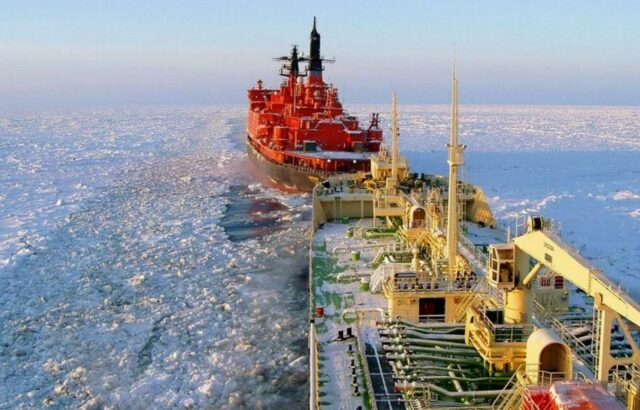
Russia Planning Year-Round Navigation of Northern Sea Route in Early 2024
Publication: Eurasia Daily Monitor Volume: 20 Issue: 94
By:

Western sanctions and changes in climate are impelling Moscow to realize a dream dating back three centuries to the time of Tsar Peter the Great—an all-water route from the Barents Sea to the Pacific through Russia’s coastal Arctic waters.
During a Kremlin video conference on May 17, Russian President Vladimir Putin stressed to participants that the Northern Sea Route (NSR) had become “extremely important” to Russia as climate change created more opportunities for shipping along the Arctic route, the shortest maritime link between Asia and Europe. Putin said, “We must think about the future. The NSR is opening up. Whether this is good or bad, it is happening” (Gcaptain.com, May 24).
While vessels have traversed portions of Russia’s Arctic coastline for centuries, severe climactic and sea conditions have inhibited voyages from the Barents Sea to the Pacific, as mariners encountered numerous obstacles from severe storms to impenetrable pack ice. Technological advances made navigation through Russian seas in the Arctic feasible. The development of steel-hulled icebreakers and the invention of radio combined with the development of powerful marine steam engines opened the possibility to develop the NSR as a transport highway. On July 28, 1932, the Soviet icebreaker Aleksandr Sibiriakov left Arkhangel’sk carrying a Soviet expedition led by Otto Shmidt and became the first ship to sail from Arkhangel’sk to the Bering Strait in the same summer without wintering en route (Arctic-russia.ru, March 16, 2022). After this historic voyage, the Soviet authorities began a series of trial runs, opening the NSR to merchant shipping in 1935. The passage’s navigational and severe climactic difficulties were paralleled by the development of an extensive Soviet railway network, leaving the route barely utilized.
The collapse of the Soviet Union in 1991 found the new Russian government eager to increase its economic interaction with the outside world, opening up previously closed transportation modes. This included the underused NSR, which was placed under Rosatomflot’s control. In this, the Russian company had constructed the world’s only nuclear-powered icebreaker fleet to open up Russia’s Arctic coastline (Gazeta.ru, May 5, 2012).
To stimulate transportation along the NSR within Russia proper, in 2022, Rosatomflot launched a regular coastal line between Murmansk and Kamchatka (Rzd-partner.ru, May 29). Currently, the NSR’s main cargo primarily consists of petroleum products, but the route’s operators hope to broaden future cargo options to include agricultural products and fish.
The increasingly harsh sanctions blowback from Putin’s “special military operation” (SVO) against Ukraine has intensified the Russian government’s search for export options immune to foreign disruption, making further development of the NSR a high priority. During the meeting with Putin, Rosatom CEO Aleksei Likhachev affirmed: “Together with Novatek, we are planning to launch year-round navigation in the eastern part of the NSR early next year.” For his part, Russian Minister for the Development of the Russian Far East and Arctic Aleksei Chekunkov reported that freight traffic along the NSR had increased from 4 million tons in 2014 to 34 million tons in 2022 (Kremlin.ru, May 17).
As the NSR is the shortest maritime route between Europe and Asia, with the added attractiveness of being solely in Russian territorial waters, the Kremlin expects significant international interest among energy-hungry Asian nations for utilizing the passage—among them China, India, Japan, South Korea and Southeast Asia—despite the threat of sanctions. The Russian government is hopeful that the NSR will eventually compete with other global routes to reach the same level as the Straits of Malacca, Singapore, Panama and Suez Canal, particularly for Beijing, New Delhi and the governments of the Asia-Pacific.
Over the past decade, China has made efforts to determine the NSR’s potential. Since 2013, COSCO Shipping, China’s largest shipping company, has made more than 20 transit voyages along the route, escorted by Russian Rosatomflot nuclear icebreakers (Expert.ru, March 27).
To gauge the NSR’s future utility for Beijing, the People’s Republic of China Consul General in St. Petersburg Wang Wenli met with the governor of Murmansk region, Andrei Chibis, and expressed interest in upgrading cooperation, noting that the Murmansk region had great potential for the development and diversification of trade relations with Chinese partners beyond energy imports. By the end of 2022, China ranked fourth among the Murmansk region’s trading partners, as, since 2019, exports had grown by 240 percent (Murmansk.sm.news, April 28).
Nevertheless, many problems impede the NSR’s transformation into a viable year-round maritime route before Shmidt’s dream becomes a reality—from building more ice breakers to improving ports along Russia’s Arctic coastline (see EDM, March 2). Beyond the economic considerations, the development of the route’s eastern section in comparison with its western segment is constrained by more severe ice conditions, shallow depths and much more.
Impelled by 11 rounds of unwanted Western sanctions, Chekunkov said that his department’s goal is to ensure that the NSR can transit up to 100 million tons by 2026 and 200 million tons by 2030. Future Chinese interest in the NSR can only increase these amounts. Given that, for Beijing, the NSR is the sole guaranteed secure maritime transport corridor if the United States and its allies try to block China’s Pacific trade routes, all that remains is haggling over prices.



